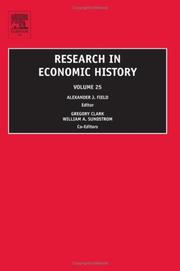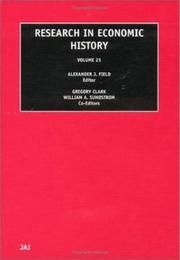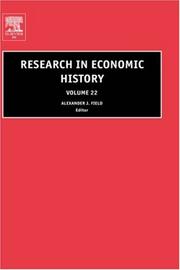| Listing 1 - 7 of 7 |
Sort by
|
Book
ISBN: 9781848553378 1848553374 1848553366 Year: 2009 Publisher: [Bingley, UK] : Emerald,
Abstract | Keywords | Export | Availability | Bookmark
 Loading...
Loading...Choose an application
- Reference Manager
- EndNote
- RefWorks (Direct export to RefWorks)
Volume 26 of Research in Economic History includes six papers, evenly divided between European and North American topics. On the European side, Stefano Fenoaltea and Carlo Ciccarelli provide new regional estimates of social overhead investment in Italy. Markus Lampe reports data on bilateral trade flows in Europe between 1857 and 1875. And Bernard Harris surveys the literature on gender, wealth, and health in England and Wales since industrialization. Turning west, Mark Kanazawa studies conflicts between ranchers and miners over who should bear the burden of taxation in nineteenth century California. Jason Taylor and Peter Klein examine Depression era cartel behavior under the National Industrial Recovery Act. Finally, James Butkiewicz mines archival material to provide a new perspective on and some rehabilitation of Eugene Meyer's role as Governor of the Federal Reserve Board between 1930 and 1933.
Economic history -- Periodicals. --- Economic history. --- Economics. --- Europe --- United States --- Economic conditions. --- Economic history --- Research. --- Economic theory --- Political economy --- Social sciences --- Economic man --- Economic conditions --- History, Economic --- Economics

ISBN: 128111247X 9786611112479 1849504598 0080556507 9781849504591 0762313706 9780080556505 Year: 2009 Publisher: Bingley Emerald Group Publishing Limited
Abstract | Keywords | Export | Availability | Bookmark
 Loading...
Loading...Choose an application
- Reference Manager
- EndNote
- RefWorks (Direct export to RefWorks)
The volume includes six papers in quantitative economic history. Peter Mancall, Josh Rosenbloom, and Tom Weiss consider growth in colonial North America, while Gary Richardson examines the role of bank failures in propagating the Great Depression. John Komlos examines the heights of rich and poor youth in England in the late eighteenth and early nineteenth century. Klas Fregert and Roger Gustafson provide a synoptic view of public finances in Sweden from the eighteenth through the twentieth century. Drew Keeling studies the economics of the steamship industry that facilitated migration between Europe and the United States between 1900 and 1914. Finally, Gregg Huff and Giovanni Caggiano examine the integration of labor markets in Southeast Asia in the late nineteenth and early twentieth century. It includes original articles written by experts on the subjects and articles supported by quantitative data.
Economic history. --- Economic conditions --- History, Economic --- Economics --- Economic history --- Economics. --- Research. --- Economic theory --- Political economy --- Social sciences --- Economic man

ISBN: 9781849501941 1849501947 0762309938 9786611049027 1281049026 0080480608 9780080480602 9780762309931 Year: 2009 Publisher: Bingley Emerald Group Publishing Limited
Abstract | Keywords | Export | Availability | Bookmark
 Loading...
Loading...Choose an application
- Reference Manager
- EndNote
- RefWorks (Direct export to RefWorks)
Volume 21 of Research in Economic History is a substantial contribution in several respects. Its heft reflects the continuing increase in quality submissions to this series, which invites (although it does not require) authors to take advantage of less stringent space limitations than is typically true in a journal article. The papers offer regional diversity: two papers with principal focus on England, one on Germany, one on Australia, and three on the United States. There are some commonalities in themes: we have three papers on 1931, three papers that have something to do with banks, two on urban economic history, and two on wage stickiness, albeit in different countries and addressing labor markets several centuries apart. What can be said of all of these inquiries, however, is that each involves the careful consideration of quantitative and qualitative data within a well articulated theoretical framework. And in almost every case, we have original analysis of primary source material. It's a pleasure in this volume to publish work of scholars at all stages of their careers. We have contributions ranging from those of recently minted Ph.Ds to those of distinguished senior scholars. Each of these articles is written with care, polish, and often passion. Academic disciplines flourish - and economic history is no exception - when scholars immerse themselves in their subjects and combine this with commitments to logic and evidence, detail, and clarity of exposition. The consequences are the fascinating papers and great scholarship evident here. We look forward to continuing to publish innovative, well written and carefully considered contributions to economic history, providing a niche which complements outlets such as the Journal of Economic History, Explorations in Economic History, and the Economic History Review. Potential contributors are urged to contact the editor for information on submission requirements.
Economic history. --- Business & Economics --- Economic History --- Economic history --- Economics. --- Research. --- Economic theory --- Political economy --- Social sciences --- Economic man --- Economic conditions --- History, Economic --- Economics

ISBN: 9781849502825 184950282X 0762311193 9786611014841 1281014842 0080498035 9780080498034 9780762311194 Year: 2004 Publisher: San Diego ; Amsterdam : JAI Press,
Abstract | Keywords | Export | Availability | Bookmark
 Loading...
Loading...Choose an application
- Reference Manager
- EndNote
- RefWorks (Direct export to RefWorks)
Volume 22 of Research in Economic History contains six papers. Three are on agriculture and two on macro issues related to the Great Depression. A concluding paper examines trends in interstate migration in the United States. Fred Pryor begins the volume with a provocative exploration of the degree to which the Neolithic revolution was in fact revolutionary. Pryor argues for a considerably lesser break with the past than has been commonly asserted. He maintains, in particular, that hunter-gatherer methods of procuring subsistence persisted alongside a continuum of agricultural practices. His evidence is drawn largely from records of surviving hunter-gatherer societies. Moving forward 10 millennia, Gregory Clark provides details of his construction of an annual price series for English net agricultural output from 1209 to 1914. Clark incorporates fresh archival material with existing published series, using consistent methods to build and aggregate 26 component series.In the third paper on farming, Giovanni Federico estimates world agricultural production from 1800 to 1938. He concludes that output grew more rapidly than population, and did so on all continents, although more rapidly in countries of Western settlement and in Eastern Europe than in Asia or in Western Europe. Federico also finds that output grew faster before World War One than in the inter-war years, and resulted over time in an increase in the share of livestock products. Continuing into the twentieth century, we have two papers on the Great Depression. First, Barry Eichengreen and Kris Mitchener explore the degree to which the seeds of economic downturn were sown during the 1920s, particularly through excessive credit creation. The authors develop quantitative measures of credit expansion and ask how well these indicators account for unevenness in the twenties expansion as well as the depth and severity of the depression in individual countries.They complement this macro analysis with sectoral studies of real estate, consumer durables, and high-tech sectors. Jakob Madsen's contribution is also based on an examination of depression macro history in a number of countries, but his focus is on output and labor rather than credit markets. he explores the perennial questions of how sticky were wages and prices and whether such stickiness played a significant casual role in the rise of unemployment. Contrary to many models that assume or assert that prices are inherently more flexible than nominal wages, Madsen finds the reverse: prices adjusted slowly to changes in nominal wages, and this stickiness played a role in propagating economic depression. Finally, Josh Rosenbloom and Bill Sundstrom explore changing rates of interstate migration by examining individual-level data from population censuses available in the Integrated Public Use Microdata Series (IPUMS). Their central finding is that propensities to migrate within the United States have traced out a U-shaped pattern, tending to fall between 1850 and 1900 and then, during the twentieth century, rising until around 1970.
Economic history. --- Economics. --- Agriculture --- Agrarian question --- Agribusiness --- Agricultural economics --- Agricultural production economics --- Production economics, Agricultural --- Land use, Rural --- Economic theory --- Political economy --- Social sciences --- Economic man --- Economic conditions --- History, Economic --- Economics --- Economic aspects. --- Economic aspects --- Economic history --- Research.
Book
ISBN: 9781849501323 1849501327 Year: 2009 Publisher: Bingley Emerald Group Publishing Limited
Abstract | Keywords | Export | Availability | Bookmark
 Loading...
Loading...Choose an application
- Reference Manager
- EndNote
- RefWorks (Direct export to RefWorks)
Book
ISBN: 9781849504409 1849504407 Year: 2009 Publisher: Bingley Emerald Group Publishing Limited
Abstract | Keywords | Export | Availability | Bookmark
 Loading...
Loading...Choose an application
- Reference Manager
- EndNote
- RefWorks (Direct export to RefWorks)
Book
ISBN: 9781849507714 1849507716 9781282526280 1282526286 9781849507707 1849507708 9786612526282 6612526289 Year: 2010 Publisher: Bingley, UK : Emerald,
Abstract | Keywords | Export | Availability | Bookmark
 Loading...
Loading...Choose an application
- Reference Manager
- EndNote
- RefWorks (Direct export to RefWorks)
Amongst other European and US focussed topics, Volume 27 addresses: the macroeconomic aggregates for England, 1209-2004; capital accumulation in Spain, 1850-2000; British Estate Acts, 1600 to 1830. Notably there is also a contribution from the late William Parker , who chapter discusses historical trends in food consumption in the United States.
Economic history. --- Economic history --- Economics --- Research.
| Listing 1 - 7 of 7 |
Sort by
|

 Search
Search Feedback
Feedback About UniCat
About UniCat  Help
Help News
News